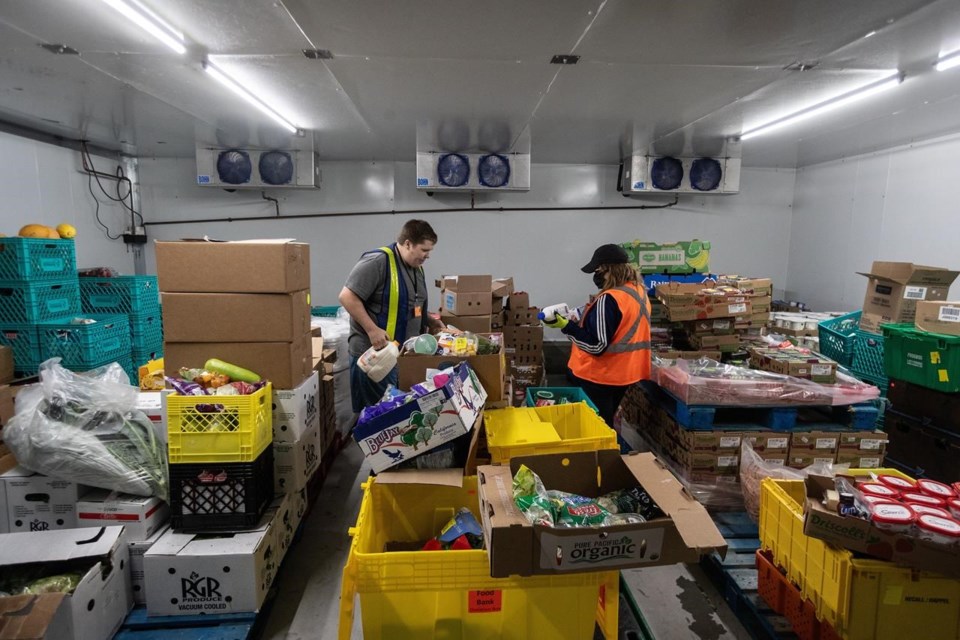EDMONTON — Half-price strawberries in stacked palletsand freshly gleaned spinach from a farm sit in a food bank's walk-in fridge waiting to be redistributed.
"There might be a few blemishes but you can just cut that off. It's still good," says Sieg Bressmer, holding a pack of deep red strawberries at Edmonton's Food Bank in the northwest part of the city.
It all has to be used within two to three days, says Bressmer, whose job is to pickfood off pallets of rescued produce every week from over 200 grocery stores in the city, including Loblaws, No Frills, Safeway and Sobeys.
The food bank has long relied on gleaning,a reference to the biblical practice of picking leftover produce from a freshly harvested farm that would otherwise go to waste. Gleaning, a type of passive charity, was practised from biblical times until the late 18th century.
Ahead of its time, the food bank in Edmonton, once known as the Gleaners Association, becamethe first food-rescuing organization in Canada in 1981.
Gerard Kennedy, one of the group's first volunteers and later the first executive director of Edmonton's Food Bank, says the idea was to reduce food waste and serve hungry families. By 1985, the group was gleaning over 70 per cent of its supply from the food industry, including retailers, farmers and manufacturers.
Kennedy remembers how at first people didn't want a food bank. Back then, he says, some people were concerned about unintentionally creating an alternative to government welfare policies.
"But what prevailed was the practicality that food should not go to waste," says Kennedy, who served as a Liberal education minister in Ontario from 2003 to 2006.
Forty years on, the role of a food bank has shifted — from focusing on gleaning surplus food to attending to greater needs of people who are visiting food banks more frequently.
Marjorie Bencz, the current executive director of Edmonton's Food Bank, says about "60 per cent of our food coming in through our doors is gleaned."
Gleaning is more relevant today, she says, with a focus on the environment and sustainability alongside food rescue. Last year, more than three million kilograms of food was gleaned in Edmonton, Bencz says.
"It's about a community feeding the community."
Bressmer, who is also a chef, says modern-day gleaning isn't about procuring food from farms but seeing what's good beyond the best-before date and how it can be given to those in need.
"People have a misconception about the expiry dates and best-before dates," he says. "The best-before are manufacturing dates to measure the optimum flavour of the food."
He trains people at the food bank to examine items, including baked goods and fresh produce, to see what's suitable for human consumption. They check for mould, blemishes or discoloration. Food that isn't good anymore goes to animals.
The only downside to rescued food is that organizations don't get to control the quantity or choose the items, says Maggie Borowiec of Moisson Montréal.
"This is food that (manufacturers) would like to sell but weren't able to," she says. "It's surplus food and their options are to either throw it or give it away."
The organization says 49 per cent of its food last year was rescued from places higher up in the supply chain. About 17 per cent was leftovers from grocery stores.
"We're fortunate in Montreal that there are a lot of food manufacturing companies, like a meat production company that gives away its surplus deli," says Borowiec.
Loblaw, Canada's largest grocery retailer, says on its website that it gave away more than 6.8 million kilograms of food to partner agencies, including Second Harvest, last year. It has set a goal of zero food to landfill by 2030.
To extend the shelf life of rescued produce, Moisson Montréal also uses an antimicrobial solutioncalled Chinook 110, for delaying spoilage, Borowiec says.
Despite efforts to rescue and glean food, Graham Hill of Second Harvest says over 60 per cent of all food produced in Canada is lost and wasted every single year.
Most would have been edible, he says.
Hill, the chief revenue officer at Second Harvest, says the organization rescued one of its largest amounts of food last year — over 24 million kilograms.
"The reason you're seeing an increase is (because) people are becoming more environmentally conscious about the impacts of food loss and waste."
Hill says there's still a lot of food being lost in a rich country where people are struggling with food insecurity.
"I'm not saying that rescued food is the answer for food insecurity. But while we have surplus food in the system, it is our duty to be able to connect as much surplus food to Canadians (as possible)."
This report by The Canadian Press was first published July 28, 2023.
-----
This story was produced with the financial assistance of the Meta and Canadian Press News Fellowship.
Ritika Dubey, The Canadian Press
Note to readers: This is a corrected story. A previous version said Gerard Kennedy, the first executive director of Edmonton's Food Bank, stated that people in 1985 were against the idea of giving out free food instead of earning a living.


